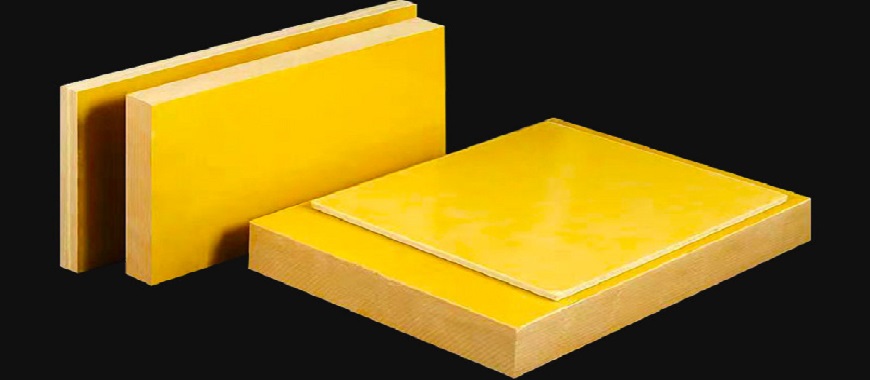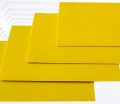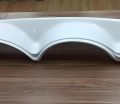
An FRP screen wall is a type of wall panel made from fiberglass-reinforced plastic, designed to provide strength, durability, and resistance to environmental factors. These panels are lightweight yet strong, making them ideal for both residential and commercial applications. FRP screen walls are known for their ability to resist moisture, chemicals, and corrosion, which adds to their long-term value. The development of FRP materials began in the 1960s when the need for lightweight, high-strength materials arose in various industries. Over the decades, FRP screen wall technology has evolved, offering more customization options and widespread use in modern construction projects.
What Are FRP Screen Wall Panels?
FRP screen wall panels are advanced construction materials composed of a blend of fiberglass and plastic. These panels are designed to provide superior durability, strength, and versatility for both residential and commercial applications. The combination of fiberglass and plastic in FRP screen wall panels results in a lightweight product that is easy to handle and install, making it an ideal solution for construction projects where weight and ease of use are important factors.
The composition of FRP screen wall panels involves reinforcing plastic with fiberglass, which enhances the strength of the material while maintaining its flexibility. This blend makes FRP screen wall panels resistant to moisture, which is essential in areas prone to dampness or humidity. This moisture resistance ensures that the panels remain unaffected by water damage, mold growth, or warping over time.
Additionally, FRP screen wall panels offer a smooth, non-porous surface, which contributes to their hygienic properties. The non-porous nature of the material prevents the accumulation of dirt and bacteria, making these panels easy to clean and maintain. This feature makes FRP screen wall panels especially useful in environments where cleanliness is a priority, such as food processing areas or medical facilities.
Benefits of FRP Screen Wall Panels
FRP screen wall panels offer a wide range of benefits, making them a popular choice in modern construction. One of the key advantages is their high strength-to-weight ratio. Despite being lightweight, these panels are exceptionally strong, allowing them to withstand significant stress and pressure without bending or breaking. This strength makes FRP screen wall panels highly resistant to damage from impacts, making them suitable for high-traffic areas.
Another important benefit of FRP screen wall panels is their excellent resistance to corrosion and chemicals. Unlike traditional materials such as steel or wood, FRP screen wall panels do not corrode when exposed to harsh weather conditions, chemicals, or pollutants. This corrosion resistance makes them ideal for outdoor and industrial applications, where the panels may be exposed to extreme environments. Whether used in chemical processing plants or exterior walls, FRP screen wall panels offer long-lasting performance without degradation.
Low maintenance is another significant benefit of FRP screen wall panels. Due to their durability and resistance to environmental factors, these panels require minimal upkeep over time. Once installed, FRP screen wall panels can maintain their appearance and functionality for years without the need for frequent repairs or replacements. Their smooth surface is easy to clean, ensuring that maintenance efforts are minimal even in environments that require high hygiene standards.
In addition to their durability, FRP screen wall panels also provide enhanced safety features, particularly their fire-resistant properties. These panels are designed to withstand high temperatures, reducing the risk of fire spread in buildings. This fire resistance makes FRP screen wall panels a preferred choice for applications where safety is paramount, such as in industrial plants or public facilities.
Customization is another benefit of FRP screen wall panels. These panels are available in a wide variety of textures and colors, allowing architects and designers to create aesthetically pleasing environments while meeting functional requirements. Whether a project requires smooth, glossy surfaces or textured finishes for added visual appeal, FRP screen wall panels can be customized to fit the desired design.
FRP screen wall panels are highly valued for their unique combination of strength, durability, and versatility. Their composition, blending fiberglass and plastic, results in lightweight panels that are resistant to moisture and easy to maintain. The benefits of FRP screen wall panels, including their resistance to corrosion, chemicals, and fire, along with customization options, make them a practical and attractive solution for both residential and industrial applications.
Thin Wall Fiberglass Tube: Revolutionizing Modern Structures
Applications of FRP Screen Wall Panels
FRP screen wall panels have versatile applications in various settings, including modular offices, industrial buildings, and residential homes. Their lightweight design, combined with high durability, makes them ideal for modular office construction. These panels provide a clean, professional look while offering superior moisture resistance, making them perfect for environments where cleanliness is a priority.
In industrial settings, FRP screen wall panels are used extensively due to their resistance to chemicals and corrosion. They can be found in machine enclosures, guarding sensitive equipment from harsh environmental conditions. Their ability to withstand heavy wear and tear makes them a valuable addition to industrial buildings. Furthermore, their fire-resistant properties make FRP screen wall panels a safer option in factories and manufacturing plants where safety is a major concern.
In residential settings, FRP screen wall panels are increasingly popular for home design. Their smooth, customizable finishes allow homeowners to select various textures and colors to match interior or exterior designs. Whether used for privacy screens, feature walls, or outdoor partitions, FRP screen wall panels combine aesthetics with practicality.
Specific Applications in Commercial Settings
In commercial environments, FRP screen wall panels are commonly found in food processing areas. These environments require strict hygiene standards, and the non-porous surface of FRP panels makes cleaning simple and effective. FRP screen wall panels resist moisture and bacterial growth, ensuring a clean environment is maintained.
Guard stations are another example where FRP screen wall panels prove effective. Their lightweight yet sturdy structure offers security while maintaining a modern, functional appearance. Similarly, machine enclosures benefit from the protection FRP screen wall panels provide against environmental damage, making them a common choice in heavy industrial areas.
FRP Screen Wall Installation
Installing FRP screen wall panels is a straightforward process, but following specific steps ensures a successful result. Before installation, it’s essential to gather the necessary tools and materials. You’ll need a drill, screws, adhesive, and a measuring tape. Proper preparation ensures the panels fit securely and evenly.
Step-by-Step Guide to Installing FRP Screen Wall Panels
- Preparation: Measure the area where the FRP screen wall will be installed. Clean the surface to remove dust or debris, ensuring the adhesive will bond correctly.
- Cutting the Panels: Depending on the size of the wall, FRP screen wall panels may need to be cut to fit. Use a fine-tooth saw to achieve smooth edges.
- Adhesive Application: Apply a strong adhesive to the back of the FRP screen wall panel. Evenly spread the adhesive using a trowel to ensure good coverage.
- Panel Placement: Press the FRP screen wall panel onto the wall, starting from one corner and working your way out. Ensure it is level and aligned properly.
- Securing the Panels: After the adhesive sets, use screws to secure the FRP screen wall panel to the wall. This adds additional stability.
- Finishing Touches: Seal the edges and any gaps to prevent moisture or dust from entering behind the panels.
Common Installation Mistakes to Avoid
One common mistake during FRP screen wall installation is improper measurement, which can result in panels that don’t fit correctly. Always double-check measurements before cutting the panels. Another issue to avoid is using too little adhesive, which may cause the panels to detach over time. Ensuring a uniform application of adhesive will improve long-term durability.
4×8 FRP Screen Wall Panels
The 4×8 FRP screen wall panel size is a popular choice for construction projects due to its standard dimensions and ease of use. These panels, measuring 4 feet by 8 feet, are widely available and easy to install, making them ideal for both large-scale and small-scale projects.
Advantages of 4×8 FRP Screen Wall Panels
One of the main advantages of 4×8 FRP screen wall panels is their versatility. Their standard size makes them adaptable to various wall sizes without excessive cutting. This reduces installation time and material waste, making the process more efficient. Additionally, the uniform size ensures that FRP screen wall panels provide consistent coverage, which is important in areas that require smooth, continuous surfaces.
Durability and Performance of FRP Wall Panels in Standard Sizes
FRP screen wall panels, particularly in the 4×8 size, offer excellent durability. They can withstand harsh environmental conditions, including moisture, chemicals, and impacts, without losing their structural integrity. This makes them ideal for both indoor and outdoor applications. Moreover, FRP screen wall panels in this size are lightweight, making transportation and handling easier during construction.
FRP screen wall panels provide a versatile and durable solution for both commercial and residential applications. Their easy installation process, combined with the availability of standard sizes like 4×8, makes them a practical choice for many projects. From industrial settings to home design, FRP screen wall panels offer a range of benefits that enhance the longevity and functionality of any space.
Transform your space with fiberglass wall sheets today
Comparing FRP Screen Wall Panels with Other Materials
When comparing FRP screen wall panels to traditional materials like wood, steel, and aluminum, there are several key advantages that make FRP stand out. FRP screen wall panels are known for their excellent corrosion resistance, lightweight structure, and long-lasting durability. These qualities make them a top choice for both residential and industrial applications, where traditional materials may fall short.
Corrosion Resistance and Durability
Unlike steel or wood, FRP screen wall panels are highly resistant to corrosion. Steel can rust when exposed to moisture, and wood may rot or warp over time. FRP screen wall panels, on the other hand, remain unaffected by moisture and environmental factors, making them an excellent choice for humid or outdoor environments. Additionally, FRP screen wall panels are durable and resistant to impacts, which extends their lifespan and reduces the need for frequent repairs.
Weight Comparison
In terms of weight, FRP screen wall panels are significantly lighter than steel and aluminum. This lightweight nature makes transportation and installation easier and more cost-effective. While wood is also lightweight, it lacks the strength and durability that FRP screen wall panels provide. The combination of strength and lightness makes FRP screen wall panels more versatile and user-friendly in construction projects.
Safety and Environmental Benefits
FRP screen wall panels also offer significant safety benefits compared to traditional materials. For example, they have fire-resistant properties that reduce the risk of fires spreading, which is a major advantage over wood. Steel and aluminum, while non-combustible, can lose structural integrity at high temperatures. Furthermore, FRP screen wall panels are more environmentally friendly, as they require less maintenance and have a longer lifespan, resulting in less waste over time.
| Material | Corrosion Resistance | Durability | Weight | Fire Resistance | Environmental Impact |
|---|---|---|---|---|---|
| FRP Screen Wall Panels | Excellent | High | Lightweight | Fire-resistant | Low Maintenance, Long Lifespan |
| Steel | Prone to Rust | High | Heavy | Loses Integrity at High Temperatures | Frequent Maintenance Needed |
| Aluminum | Moderate | Moderate | Lightweight | Fire-resistant | Moderate Impact |
| Wood | Prone to Rot and Decay | Low | Lightweight | Combustible | High Maintenance Needed |
Cost Comparison of FRP Screen Walls
The initial cost of FRP screen wall panels may be higher than traditional materials, but their long-term savings are significant. One of the main reasons for this is the reduced maintenance required for FRP screen wall panels. While wood needs regular treatment to avoid rot and steel may require corrosion protection, FRP screen wall panels are virtually maintenance-free. This leads to substantial savings in maintenance costs over time.
Long-Term Value for Homeowners and Businesses
For both homeowners and businesses, FRP screen wall panels provide a durable and cost-effective solution. While the upfront cost may seem higher, the reduced need for repairs and maintenance makes FRP screen wall panels a more economical choice in the long run. For example, in industrial settings, where exposure to chemicals or moisture is common, FRP screen wall panels hold up far better than steel or wood, which would need frequent replacements.
Durability and Longevity of FRP Screen Walls
The superior durability of FRP screen wall panels translates into a longer lifespan compared to other materials. Over time, wood can warp, crack, or rot, while steel may corrode or rust in certain environments. FRP screen wall panels, however, are designed to withstand these conditions, offering reliable performance for decades. This longevity reduces the need for replacement, which lowers the overall cost of ownership.
FRP screen wall panels offer clear advantages over traditional materials when considering corrosion resistance, durability, weight, and safety. Though the initial investment may be higher, the long-term savings and value make FRP screen wall panels a superior choice for homeowners and businesses looking for a reliable and cost-effective wall solution.
Why Choose Brown Fiberglass Insulation for Attics and Walls
The Increasing Popularity of FRP Screen Walls
At GangLong Fiberglass, we have seen firsthand the growing demand for FRP screen wall solutions across various industries. The versatility, durability, and lightweight nature of FRP (Fiberglass Reinforced Plastic) have made FRP screen wall panels a top choice in modern construction projects. These panels are now widely used in sectors such as industrial, commercial, and residential building projects, where strength and resilience are essential.
As more industries look for reliable, low-maintenance materials, FRP screen walls are quickly becoming a popular option. Their ability to withstand harsh environmental conditions, including exposure to moisture, chemicals, and extreme temperatures, makes them ideal for outdoor and industrial applications. In addition, the sleek, modern appearance of FRP screen wall panels has led to their increased use in commercial projects, where aesthetics and functionality are equally important.
Why FRP Screen Walls Are Becoming Common in Construction
The rising popularity of FRP screen walls in modern construction is largely due to their impressive strength-to-weight ratio and ease of installation. At GangLong Fiberglass, we take pride in offering FRP screen wall panels that are both lightweight and incredibly durable. This makes them easier to transport and install compared to traditional materials like steel or wood, saving time and labor costs on-site.
Additionally, FRP screen wall panels require minimal maintenance. Unlike other materials that may need frequent repairs or replacements, FRP screen walls resist corrosion and damage, providing long-lasting performance. This durability makes them a cost-effective solution for builders and property owners alike.
The Evolution of FRP Technology
Over the years, FRP screen wall technology has evolved significantly, leading to improvements in both performance and customization options. At GangLong Fiberglass, we have embraced these advancements by offering FRP screen wall panels in various colors, textures, and finishes to meet diverse project needs. These innovations ensure that FRP screen walls not only deliver in terms of durability but also enhance the aesthetic appeal of any space.
FAQs about FRP Screen Wall
FRP wallcovering refers to a type of wall panel made from fiberglass-reinforced plastic (FRP). It is designed to provide durability, strength, and moisture resistance. FRP wallcovering is commonly used in both residential and commercial applications due to its high resistance to environmental factors like water, chemicals, and impact. This makes it an ideal choice for areas that require low maintenance and long-lasting protection. Additionally, FRP wallcovering is easy to clean, which is why it is often used in places like kitchens, restrooms, and industrial spaces. The smooth, non-porous surface prevents the growth of bacteria and mold, adding to its appeal in hygienic environments.
Yes, FRP is a great choice for shower walls due to its excellent moisture resistance. Since showers are constantly exposed to water and humidity, having a material that can withstand these conditions is essential. FRP screen walls offer a smooth, non-porous surface that prevents water from seeping through, helping to avoid mold and mildew buildup. In addition to being waterproof, FRP panels are also easy to clean, making them an ideal solution for maintaining hygiene in bathrooms. Their durability ensures that they won’t warp, crack, or degrade over time, even with constant exposure to water.
Yes, FRP wall panels are fully waterproof. This is one of their primary advantages, making them suitable for environments with high moisture levels. FRP screen walls are designed to resist water penetration, which prevents mold growth and maintains the integrity of the wall over time. Their non-porous surface ensures that no water is absorbed, and the panels remain unaffected by humidity or direct water exposure. Whether used in bathrooms, kitchens, or industrial settings, FRP wall panels provide a durable, water-resistant solution that requires minimal maintenance.
When comparing FRP and PVC, each material has its strengths, but FRP tends to be more durable and resistant to damage. FRP screen walls offer superior strength compared to PVC, making them more suitable for high-traffic or industrial environments. While both materials are water-resistant, FRP is also resistant to chemicals, impacts, and fire, giving it an edge in certain applications. PVC is lighter and can be easier to install, but it may not offer the same level of long-term durability that FRP provides. In terms of overall resilience and performance, FRP is often the better choice for demanding environments.

As the editor of GangLong Fiberglass, I have years of experience and in-depth research, focusing on cable tray products, fiberglass solutions, and grille systems. I incorporate years of industry insights and practical experience into every content, committed to promoting the progress of the industry. At GangLong Fiberglass, my commitment is reflected in every product, from innovative cable trays to durable fiberglass solutions and sturdy grille systems. As an authoritative voice in the industry, my goal is to provide valuable information to professionals and businesses and promote forward-looking solutions.


